wireless speaker
Latest
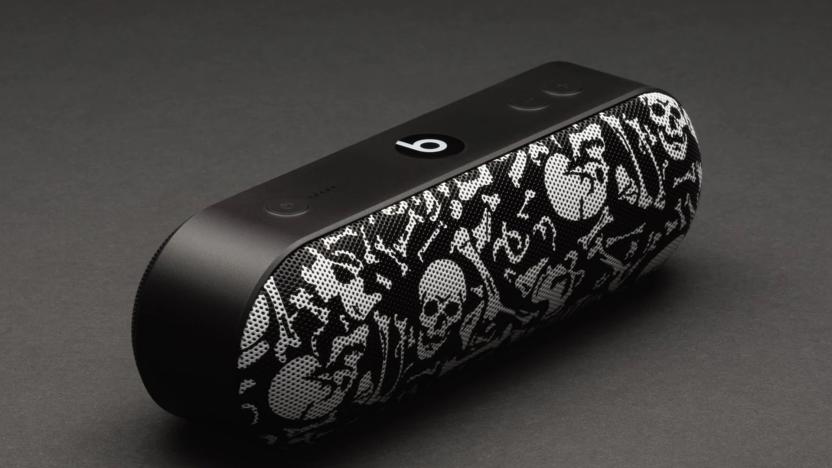
Beats revives its discontinued Pill+ speaker for a Stüssy collab
Beats is resurrecting its Pill+ speaker for a limited edition collaboration with Stüssy.

Astell & Kern's first Bluetooth speaker includes a 32-bit DAC
Astell & Kern has unveiled its first Bluetooth speaker, and it caters to enthusiasts with a 32-bit DAC and 24-bit codecs.
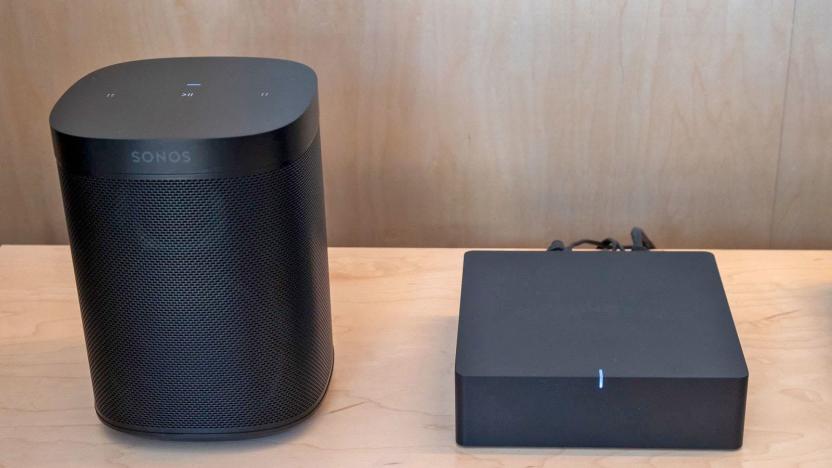
Sonos' One SL speaker is now more power efficient
The new model of the non-microphone variant of the Sonos One features a more efficient wireless radio.
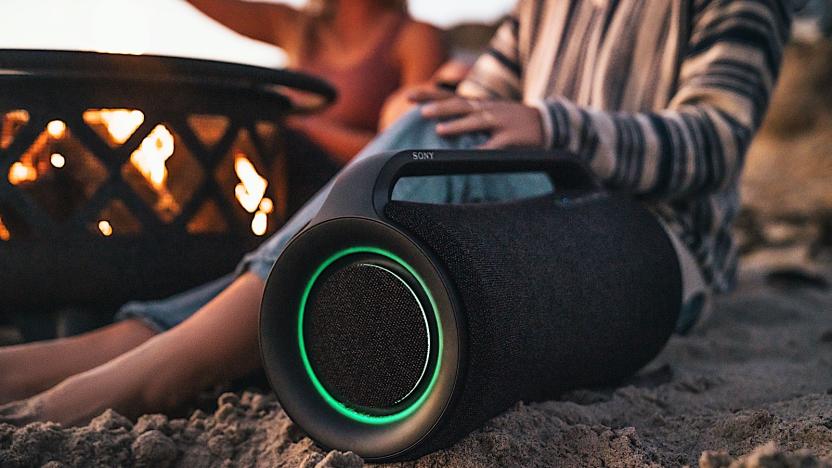
Sony adds four new models to its portable wireless speaker lineup
This year's Sony portable speaker lineup includes an ultra compact model along with three larger options for parties and karaoke.
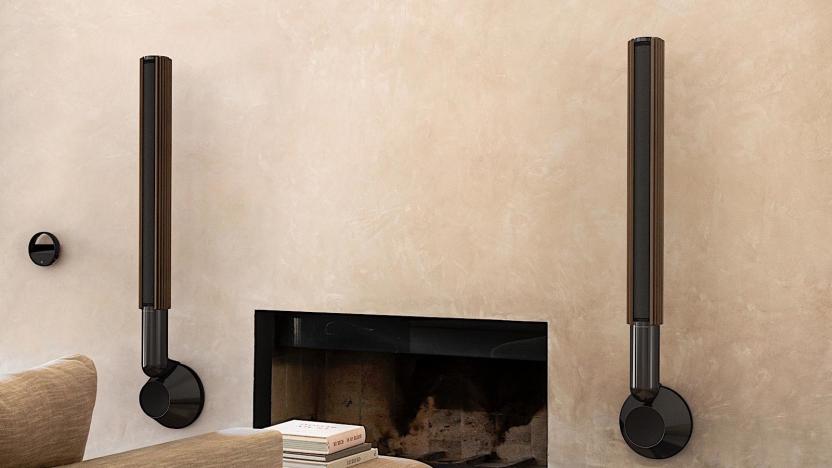
Bang & Olufsen's Beolab 28 is a $14,750 pair of connected speakers
Bang & Olufsen's latest high-end wireless speakers are equipped mechanical curtains that move to adjust how the speakers project sound.
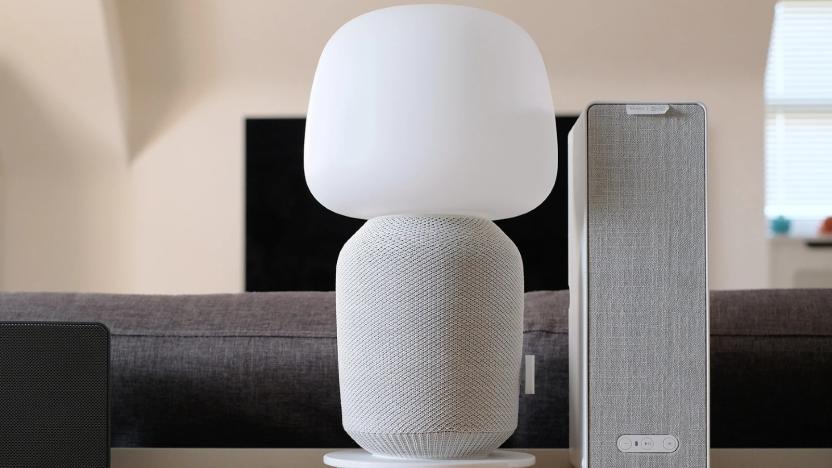
Sonos and IKEA are developing new Symfonisk speakers that hide in plain sight
According to a new report, one of the new devices IKEA and Sonos are working on is a speaker that will double as an art piece.
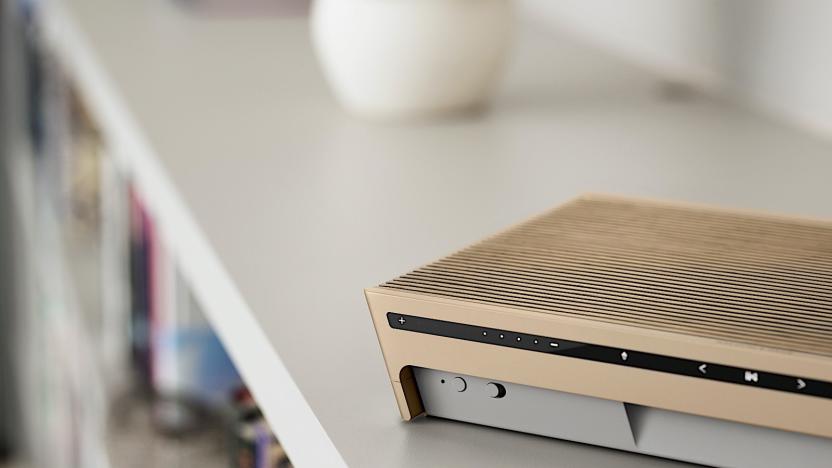
Bang & Olufsen's $1,500 'portable' speaker is designed to last decades
Bang & Olufsen's latest speaker is both portable and sports a modular design the company says will improve longevity. And, of course, it's expensive.
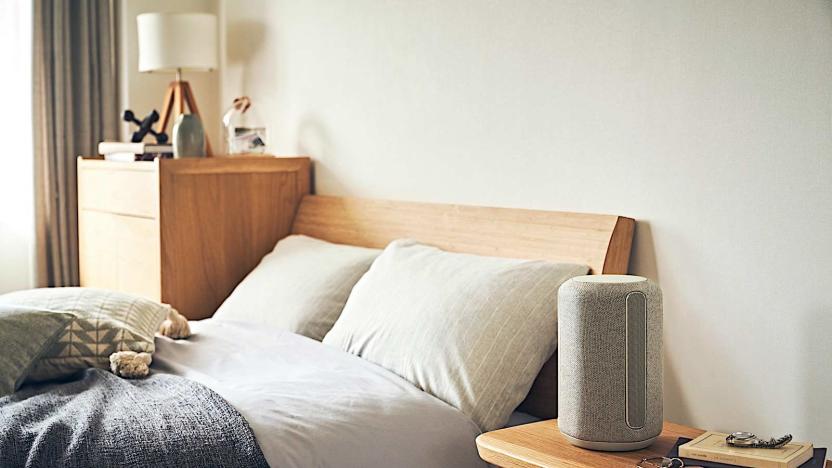
Two years in, Sony wants to bring 360 Reality Audio to the masses
Sony's plan to bring its immersive 360 Reality Audio to more people includes the combo of new speakers, more content, software plug-ins and licensing.
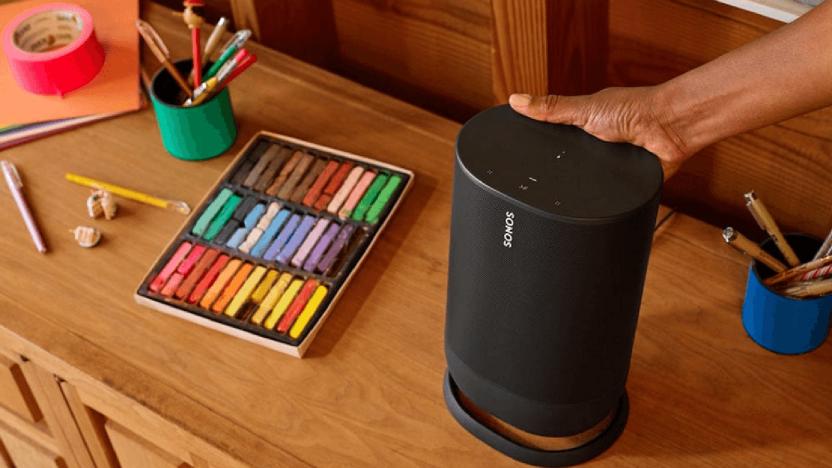
Sonos' portable smart speaker leaks in greater detail
There might not be much of a surprise left by the time Sonos unveils its first portable speaker. The crew at WinFuture has obtained pictures and details that appear to offer much clearer idea of how the hybrid smart speaker will work -- including what it's called. Known as the Sonos Move, it won't be just a slightly squashed Sonos One with a battery. There looks to be a recessed grip to help you tote the speaker from place to place, and that's where you'll also find the previously rumored toggle between Bluetooth (portable) and WiFi (home) connections.
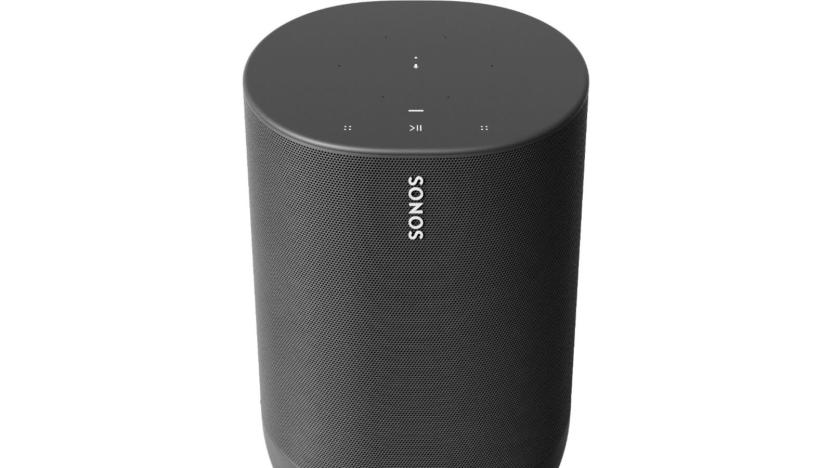
Sonos' leaked portable speaker automatically tunes its sound
Sonos isn't having much luck preserving the mystery for its fall product launches. Zatz Not Funny and The Verge have obtained details for what's said to be Sonos' first portable speaker, and it'll offer a few twists on the familiar formula. To begin with, it'll support both the usual WiFi networking at home and Bluetooth when you're on the road. A button toggles between one wireless mode and the other. It even has its own charging base for home use, although you can charge with a USB-C cable if you're in a pinch.
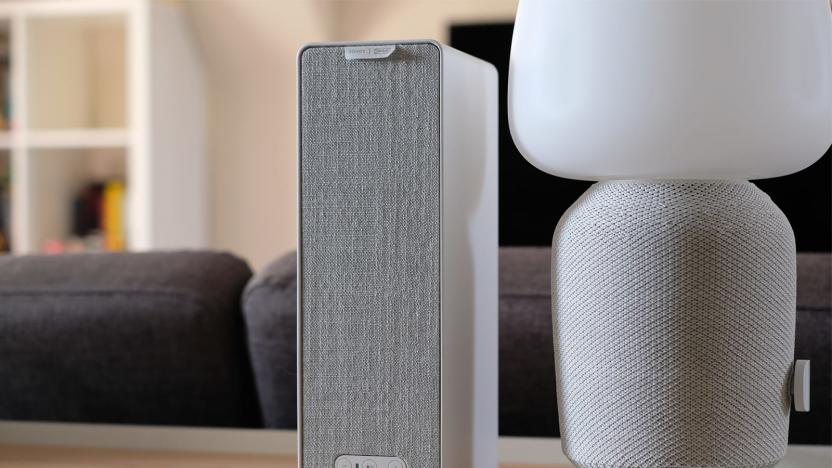
IKEA's Sonos-powered speakers are available now
After a months-long wait, IKEA's Sonos-powered SYMFONISK speakers are finally available. They're sitting in the furniture giant's stores as of today (August 1st) and should be available online "soon." As before, what you choose depends both on the audio quality you expect and how you'll use them to furnish your home. The $99 bookshelf speaker is both the most affordable option and can double as a shelf of its own if you buy the $20 wall bracket. The $179 table lamp, meanwhile, is both a handy light source and a more powerful speaker comparable to Sonos' Play:1.
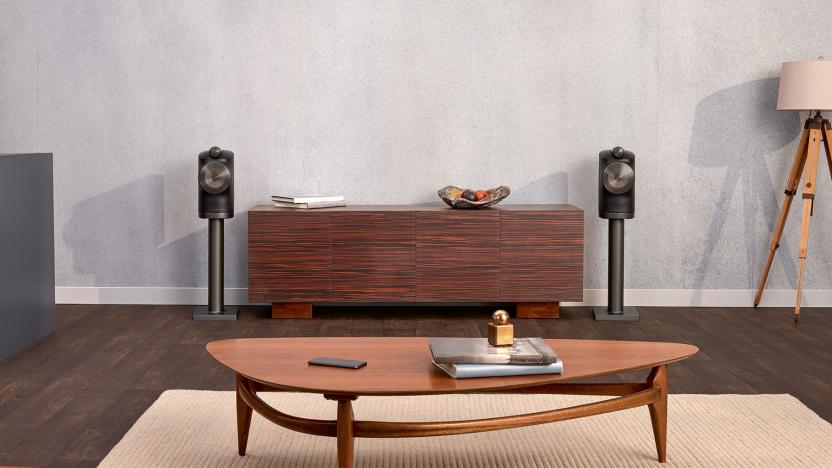
Bowers & Wilkins is betting big on high-end, multi-room streaming
For Andy Kerr, product communication director at Bowers & Wilkins, Formation has been a long time coming. "We're following a path that we've wanted to be on for... probably since the start. Since the inception of the company."

Bowers & Wilkins unveils wireless Formation speaker family
Bowers & Wilkins, best known for its luxurious Nautilus and 800 Series Diamond speakers, is launching a wireless audio system called Formation. The company is starting with a soundbar, two bookshelf-style speakers, a cheaper single speaker, a standalone subwoofer and an audio box that gives older devices streaming capabilities. All five pieces will work separately or in tandem for a multi-room experience similar to Sonos.
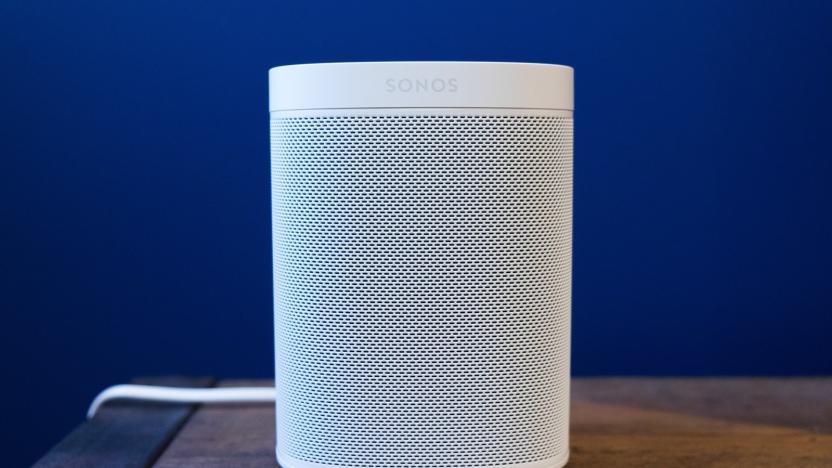
Alexa can finally control Apple Music on Sonos speakers
Amazon may have been a little optimistic when it said Alexa would "soon" control Apple Music on third-party speakers, but that feature is here at last. Listeners in the US, UK and Ireland can now use Alexa to steer Apple's service on Sonos speakers like the One and Beam, giving you the convenience of voice control while providing more oomph than most Echo speakers. Think of it as a more frugal alternative to owning a HomePod.

IKEA offers a peek at its Sonos-based speaker
IKEA isn't officially unveiling its first Sonos-powered speaker until April, but that isn't stopping the furniture store from offering a look in the meantime. As you can see here, the SYMFONISK looks like... well, a Sonos speaker with IKEA design cues. Its boxy, fabric-covered style appears to be a fitting complement to your plywood tables and cabinets. The company even suggests that it could serve as a wall-mounted shelf (below), although that would make it an awfully expensive part of your decor.
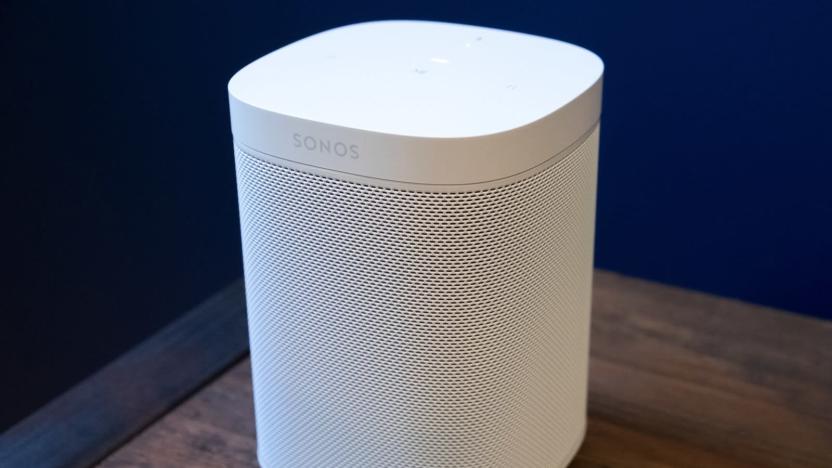
Sonos One speaker now packs more powerful internals
How do you improve the Sonos One speaker when there aren't too many qualms about the basic design? If you ask Sonos, it's all about future-proofing. The company is rolling out a Gen 2 version of the One that shares the same design, but includes Bluetooth Low Energy, a newer processor and more memory. In other words, it should perform next-generation tasks that would simply be too much for the original to handle -- not that Sonos is saying just what those additions might be.
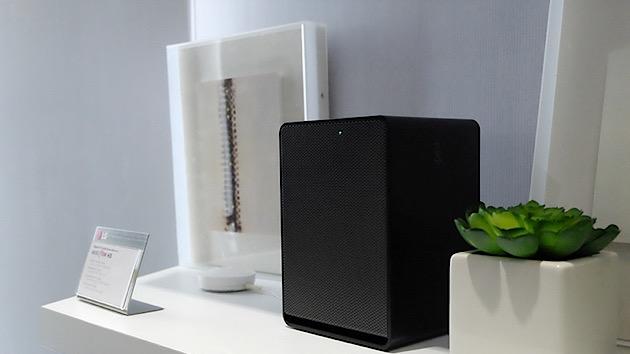
LG's answer to Sonos is a lot like Sonos
LG debuted its Music Flow series of wireless speakers last summer, offering a range of speakers targeted squarely at competitor Sonos' products. More recently, it moved away from aping Sonos with the H4 Portable, a battery-powered speaker that acts just like its larger siblings. At CES 2015, we took a closer look (and listen) at the whole Music Flow family. The way Music Flow works is a hybrid of Sonos and a traditional Bluetooth or NFC speaker. You can pair speakers with a phone via NFC and dedicated apps for iOS and Android, or you can control them directly over a WiFi connection. They speak with one another over WiFi, but need a hub to do so -- a requirement Sonos recently dropped.

Denon Envaya is a portable Bluetooth speaker with loads of oomph
Denon is an audio company renowned for producing high-quality, high-end hi-fi equipment. The Envaya (US$199) represents Denon's current offering into the portable speaker market. Having recently reviewed Ultimate Ear's Boom and the pricier (compared to both the Boom and Envaya) Libratone Zipp, I was keen to see how the Envaya compared. Design Where the Boom and Zipp are cylindrical, the Envaya takes a more traditional rectangular shape. It's fairly large compared to the Boom (width 25.5 cm x height 1.41 cm x depth 4.75 cm) and weighs just under 3 lbs, so it's not as large as the Zipp. Having said that, the Envaya could easily be carried around in-hand or slipped into a rucksack. I wouldn't say the Envaya has an exciting, bold design like the Boom, or a sophisticated look like the Zipp, but it's not bad looking either. Similarly, it doesn't feel cheap, but it doesn't feel premium either. The Envaya comes in either black or white, but on the front is a grill with an interchangeable, colored cloth underneath. There are four colors (lunar, indigo, fandango, sunset) which do give the speaker some personality, but it's subtle. The Evanya may not stand out with its looks, but it's well put together and has a sturdy, durable quality. There's a kickstand round the back that snaps out with a squeeze to stand the Envaya upright. The kickstand collapses with a satisfying click when you press down, to make it easier to transport or store. On top is a row of large, back-lit buttons (power on / off, pairing, mute, volume up / down, and aux) as well as a battery indicator light. On the right hand side is a power input, a 3.5mm aux input, a reset button and a USB port for charging your iOS device from the Envaya's battery. On the bottom is a rubbery grip, keeping the Envaya steady and stable. Inside are what Denon calls two Full Range Drivers and in between them is a Passive Radiator for the bass, all driven by a digital amplifier. Performance Pairing the Envaya to my iPhone was really easy with Bluetooth. The Envaya chimes when pairing is complete and the Bluetooth pairing button's backlight is constantly on to indicate the connection. Multiple devices can be paired with the Envaya. I found the Envaya had really good Bluetooth range, too. The first thing I noticed from the Envaya when I played a track through it was that it had oodles of bass. It was surprising just how much of a punch the Envaya had, especially compared to the Zipp, where I felt bass was slightly lacking. However, the extra bass comes at the expense of higher end detail and openness. Things tended to sound a little muffled in the upper ranges. The Envaya has loads of volume though, easily filling a good-sized room with music. Denon says the Envaya has 10 hours of battery life and charges in 2.5 hours. I found the battery life to be on par with that, lasting a good few days with intermittent usage. The speaker's USB port for charging is a nice extra for those emergency low-battery moments, too. Conclusion For a portable speaker, the Envaya has a great deal of volume and bass oomph, making it a great choice for impromptu parties and the like. Battery life and Bluetooth performance are solid, and the USB charging port is a useful extra, but the veiled high-end left me wanting a little more from its audio performance. Having said that, if you're a bass-heavy fiend, the Envaya will be exactly what you're looking for in a portable speaker.

Sonos Play:3 and Play:5 wireless speakers review for Mac and iOS
A little while ago I reviewed the Sonos Play:1 speaker. I was thrilled with how the speaker packed a real punch in sound, performance and design. Over the last few weeks I've had the addition of the the Sonos Play:3 (US$299) and Play:5 (US$399) to add to the Play:1, creating a truly wireless sound system for three rooms in my flat. Design The Play:3 and Play:5 take ques from the Play:1's design and appearance, but get respectively larger in size and sound performance. Like the Play:1, both the Play:3 and Play:5 come in black or white. The speakers have a minimalist appearance that allows either to settle into any room of the house, without looking out of place or intrusive. The Play:3 has 3 speakers powered by 3 Class-D digital amplifiers. There's a single tweeter, two mid-range drivers and a novel bass radiator that uses energized air volume from within the Play:3 to generate low, bass frequencies. It really works, too. The Play:3 can also be placed horizontally or vertically, with rubber feet to suit either orientation. Better still, the Play:3 automatically adjusts its own EQ depending on its orientation, to make sure you're getting the best sound out of it. The Play:5, on the other hand, ups the speaker count. There are 2 tweeters, 2 mid-range drivers and a dedicated sub-woofer handles the bass, each powered by a dedicated Class-D amplifier. The Play:5 also offers an analogue, 3.5mm input, something that the Play:1 and Play:3 are noticeably lacking. Like the Play:1, the Play:3 and Play:5 can be paired with an additional, respective model to create a truly stereo sound-stage. Performance There's no doubt that, as much as I love the Play:1, placing the Play:3 alongside it revealed its weaker points. Compared with the Play:1, the Play:3's extra speakers and amplifiers add extra warmth, breadth and depth to whatever you put through it. Of course, the Play:3 is double the size of the Play:1. Also, the Play:3 costs $100 more than the Play:1, so it makes sense that the Play:3 sounds $100 better. I think it appropriately does. I had a similar experience placing the Play:5 alongside the Play:3. Compared with the Play:3, the Play:5 has more subtlety and breadth in the higher-end as well as a natural warmth from that sub-woofer. With Sonos' Loudness feature turned off (simply put, a feature that lifts the lower end to compensate for low volume), it was even clearer that the Play:5 has more to deliver, thanks to that additional tweeter and sub-woofer. The Play:5 also has a much wider stereo sound-stage thanks to it's larger form factor. Once more, it stands to reason that for $100 more than the Play:3, the Play:5 comes out on top. Teaming up all three speakers was a joy. Having perfectly synced music in three different rooms in the house was a pleasure. Likewise, to play different tracks in different rooms at the same time was also a real boon. The Sonos Bridge handled it all flawlessly, with no dropouts or stutters. I discussed the Sonos iOS and Mac apps in my Play:1 review. After a few more weeks of using it, I still feel there are some frustrating niggles. A newly discovered frustration was that certain features are missing from the Sonos app that are standard in native music players. For example, with Spotify in the Sonos app, I missed features like recommendations, playlist and profile search results and Spotify Radio. To me, that illustrates how the Sonos app will always be slightly lacking in features that native music players will continually be adding. It's going to be impossible for Sonos to keep up with the addition of new features in every music player. However, the Sonos app does cover the basics and, for most, the essentials. Furthermore, the more I used the Sonos app, the more apt I became at getting what I wanted out of it. Conclusion Sonos offers rock solid wireless delivery of music in your home. For wireless music delivery, you need not look further than Sonos. Adding to the Sonos system is exceptionally easy, and for getting your music around your house, much better than independent systems in each room. The only question is which Play speakers do you go for? I absolutely loved the Play:1 when I tested it, but it's clear that things improve with the Play:3 and and even more so with the Play:5. Naturally, at a price. Walking away from the Play speakers, I really felt each speaker delivered fantastic value for money in their respective class. Basically, you won't be disappointed, no matter which Play speaker you go for. However, if you can choose, I'd suggest that for everyday use, where you're looking for a soundtrack to what you're doing, the Play:1 and Play:3 will absolutely hit the spot. But for those moments, or rooms, where you want the best Sonos has to offer and the most from your music, the Play:5 is the speaker to go for.
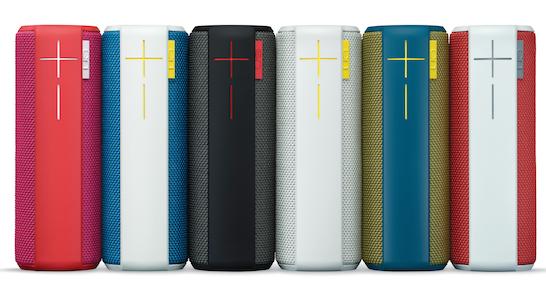
UE Boom for iOS, Mac is a superb and portable Bluetooth speaker
The UE Boom (US$199) by Ultimate Ears is a portable, Bluetooth-enabled wireless speaker compatible with Mac and iOS devices. If you've ever grown tired of the limited quality of your MacBook, iPhone or iPad's speaker (and let's face it, who hasn't?), the UE Boom is designed to bring high-quality, long-lasting audio to your device in a robust, easy-to-use, portable form factor. Features The Boom is small, about the size and shape of an old-school cylindrical pencil case (diameter: 6.5cm, height: 18 cm). It's easy to pick up, and even hold for extended periods of time in your hand. It's compact enough to shove in a bag and durable enough for you not to worry about it getting damaged while it's in there. It's solid too; nothing rattles and there are no moving parts. It's weighty (538g), but not heavy. It's even water resistant with a Level 4 Ingress Protection Rating. The Boom is designed to be used anywhere: the kitchen, the bathroom, the car, a camping trip or even on a bicycle ride. There are four buttons on the Boom. On the top are the power button and a Bluetooth pairing button. On its side are two large, indented volume-up and volume-down buttons in the shape of "+" and "-" symbols, which are easy to find, but sometimes difficult to push. Pressing the power button turns the device on. The button lights up and the Boom plays a little drum roll, telling you it's alive and well. Pressing and holding the Bluetooth pairing button allows the Boom to be paired with up to 8 devices. When pairing happens, a shorter drum-roll sounds. The effect is endearing, and it's useful too. The Boom's underside has a micro-USB input for charging, a 3.5mm audio input and a hook to affix the Boom to things. The Boom is colorful. It comes in a multitude of dual-color pairings or more extravagant custom editions. The color really adds to the Boom's appeal, saying so much more about the excitement of listening to music than other wireless speakers that remain dull and neutral. In terms of design and quality, the Boom is one of the best accessories I've had the pleasure of reviewing. It really is a pleasing and exciting piece of kit to behold and use. Finally, the Boom has a companion iOS app to update the Boom's software as well as adjust settings, enable 2x pairing of two Booms, for a stereo sounndfield or just double the volume, and a handy alarm clock feature, where your Boom plays the last played track as a wake-up call. Performance The Boom continues to impress in the audio department. Sound is clear and dynamic. Whatever you seem to put through the Boom, it produces an exciting and engaging listen -- all this coming from a portable, wireless speaker. The 360-degree sound is room filling and can get very loud. I found I never really took the Boom much past half-way volume when indoors, but would happily crank it up for an impromptu social gathering or using it outdoors. At high volumes the Boom held its composure and didn't distort. If anything, I found putting the volume up exposed the nasty flaws of lesser-quality audio files. Using Spotify's high-quality playback, the Boom provided a compelling listen, even distracting in a good way. As engaging as the sound is, I did find the Boom missed out on the finer details that might be found on higher-end equipment. Pairing the Boom to my iPhone and iPad was effortless. Once paired, you choose the Boom from the AirPlay menu wherever you see it in iOS. Volume is adjusted and mirrored whether you change it on the Boom or your iOS device. It's important to note that the Boom doesn't take advantage of Apple's AirPlay technology, so you don't need a WiFi router to use it. However, using Bluetooth means that signal range is limited. UE says the Boom has 15 meters or 50 ft of range. However, I found that indoors, with walls and doors to contend with, the Boom started to drop signal after about 8 meters. A great little bonus feature is that the Boom has a built-in mic, which means you can take and receive phone calls through the Boom. However, all control needs to be done on your iOS device. It was a little disappointing to find that the Boom couldn't take advantage of Siri to make or take calls, let alone change tracks. Pairing on the Mac was just as straightforward as on iOS, but I found the Boom didn't have the same ease and responsiveness in terms of controlling volume, switching apps, etc as it does on iOS. Playing music was fine, but I couldn't always get system sounds to come through the Boom. In another instance, I couldn't hear a Skype call ringing, but could have the conversation through the Boom. Things seemed temperamental. It'd be great to see these little kinks worked out in a software update. Bluetooth pairing also means that multiple devices don't always work as coherently as multiple devices do with AirPlay. If I was playing a track on my iPhone and then "interrupted" that track by playing a track from my Mac, the track from my iPhone wouldn't stop, but just become disjointed and distorted. I found I had to stop playback on one device before I could play something from another. A couple times I had to power down the Boom and re-pair it to get rid of little distortions and corrupted playback. UE says the Boom has a battery life of 15 hours. While I didn't do an extensive battery test, I found the battery lasted extremely well when the volume wasn't pushed excessively for long periods of time. I easily got through a day of playback with the Boom sitting at my desk. The Boom can also be powered by the included USB cable plugged into a wall socket or USB power supply, so if the Boom's battery does run out, the party doesn't have to end there! Conclusion In short, the Boom is the best portable music speaker I've used. It looks fantastic, is seriously portable, is a pleasure to use, and the sound it produces is exciting and entertaining. At this price point, there's not a better wireless speaker out there that I know of. There are a few niggles; no Siri integration for iOS devices, operation as an audio output on the Mac is a little buggy when working with certain applications, and Bluetooth range is somewhat limited in comparison to AirPlay when indoors. However, the pros far outweigh the relatively minor cons here. The UE Boom is the portable wireless speaker to get. Rating: 4 stars out of 4 stars possible





